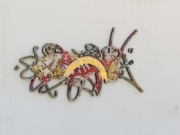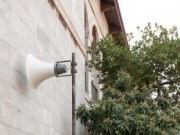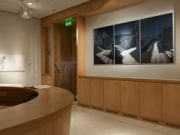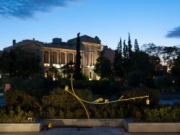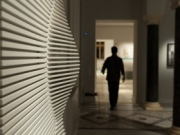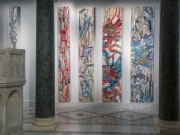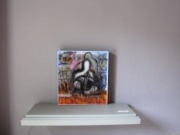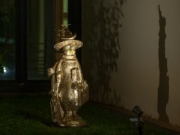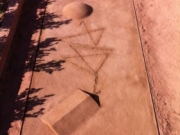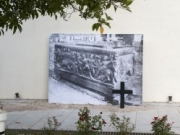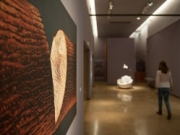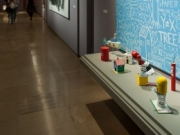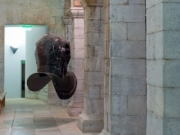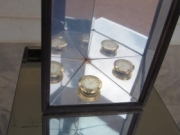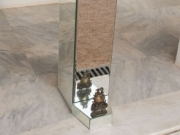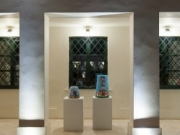25 September 2014 until 29 October 2014
διάλογος / διαμόρφωση / διάλυση / διάρρηξη / διαπλοκή / διάπλαση / διάδραση / διαφορά / διατήρηση / διάταξη / διαταύτα / διαβιβάζω / διάγραμμα / διαγώνιος / διαδικασία / διαδραματίζω / διαδραστικότητα / διάθλαση / διαδίκτυο / διάδοση / διαδοχή / διαδρομή / διαίρεση / διαίσθηση / διαιωνίζω / διαφθορά / διακειμενικότητα / διάκενο / διακοπή / διακορεύω / διάκοσμος / διάκριση / διακριτικός / διακύμανση / διαλέγω / διαλεκτική / διάλεκτος / διαλεκτός / διάλεξη / διαλλακτικός / διαλογίζομαι / διαλογή / διαλογισμός / διαμαρτυρία / διαμάχη / διάμεσος / διάμετρος / διανόηση / διάνοια / διαρρυθμίζω / διασάλευση /διασάφηση / διασκευάζω / διασπώ / διάνυσμα / διαξιφισμός / διαπάλη / διαμπερής / διάρθρωση / διάρκεια / διασυνοριακός / διασταύρωση / διασκευάζω / διαμέσου
Each participant chooses one of the above words or any other word from the dictio-nary that includes the preposition “dia” (inter- in English). Then, she or he identifies a place within the Byzantine Museum that could express spatially and artistically the selected word. The exhibition DIA aims to open a dialogue between artists, architects, theorists, and the public. | Each one participates with one work. | Both the goal and the objective of the exhibition is the dia-logue between Artists and Architects, a dialogue among the dif-ferent generations of creators and their association with the Byzantine Museum place. We live in a multicultural, multiethnic, interactive, dialectic era that contains many DIA issues to process. | The Byzantine museum is a place of power and history. The existence of the main courtyard, an outdoor space, is an extremely interesting element. Such an atrium in the heart of Athens brings the visitor in contact with the soil. The soil functions as the primal material for both architects and artists by generating motivations and thoughts for further processing. Through the lens of DIA two different fields are in conversation. The fact that the majority of the works are created exclusively for the DIA exhibition and are exhibited in specifically defined spaces of the Byzantine Museum generating a unique path for the visitor, has to be highlighted. Respectively, the architecture and art theorists create their own works - texts. The place and the relation of the space to the work, are of high importance and thus comprise the main axis of the exhibition concept.
Dora Theodoropoulou
Architect, Curator
Elina Theodoropoulou
Visual Artist, Curator
A real dialogue with the Byzantine museum. Based on the selected word, each artist explores its spatial development in the outdoor and indoor spaces of the museum by generating a dialectic relation both with space and time. | It is about a journey throughout the centuries. By finding his/her space, the artist internalizes a fragment of history through experience. The awareness of the journey takes place in phases, through negotiations, modifications and thoughts that are generated by the contact with the space and the various views. | The preposition “dia”, gives an element among men, eras, civilizations and leads each one to a different unique journey that individualizes and brings one in dialogue, at the same time. Existing as an individual and as a group. An individual, artist or architect, because of a creation that is based on personal experiences. A group, because of the common objective even if it leads to different journeys.
Elina Theodoropoulou
Visual Artist, Curator
Above all, DIA is a calling. A calling for creation, thinking, questioning, dialogue. The place, the timing, and the people compose the DIA exhibition. Traces of the past, material and immaterial. Memories of the space from near or distant past. Duchess of Plaisance. | We are guests of the present, but also guests of what the presents carries as history. The works, each one on its own and all together contribute to the composition of DIA. The intention is, that they would all function as an aggregate so that at the end of the path within the exhibition the visitor gets an overall sense – in parallel to the Byzantine gaze, a gaze that is mostly spherical than linear. | The DIA concept symbolizes for us the in-between space, between two opposites, two polarities. It has been approached by philosophy and religion since a long time, it remains always up-to-date and asks for answers or just re--pose questions. How do we inhabit this space? How do we approach this in-between space in art and architecture? | DIA has its roots in childhood. | A game, a rectangular or square shape on paper, where the names of our beloved ones are written. | The artists, the architects, and the theorists approached DIA with their own unique way. DIA is not static. It moves and is shaped by all of us every moment.
Dora Theodoropoulou
Architect, Curator










